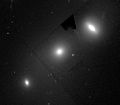NGC 7236
NGC 7236 is an
light years from Earth, which, given its apparent dimensions, means that NGC 7236 is about 150,000 light years across.[1] NGC 7236 forms a pair with NGC 7237 and is a radio galaxy. It was discovered by Albert Marth on August 25, 1864.[3]
NGC 7236 forms a pair with
keV. The total mass of that gas is estimated to be 3×1010 M☉.[4] A smaller elliptical galaxy, NGC 7237C, lies 38 arcseconds southeast of NGC 7237. A faint tail emanates from NGC 7236.[5] It is included in the Atlas of Peculiar Galaxies, in the category diffuse counter-tails. A tail is also visible in X-rays.[6] A dust lane runs across the galaxy.[7]
The galaxy pair is a source of radiowaves. The radio emission has a double lobe structure, with filaments, but no jets, while a weak core is identified as the nucleus of NGC 7237.[8] The filaments could be created by the interaction of hot gas with the preexisting radio emitting plasma. Some bright radio sources are visible within the lobes but they could be background active galaxies.[6]
Gallery
-
Arp 169 by the Hubble Space Telescope
-
The radio emission of 3C 442 by the Very Large Array
References
- ^ a b c d e f g h i "NASA/IPAC Extragalactic Database". Results for NGC 7236. Retrieved 2023-07-07.
- ^ "Revised NGC Data for NGC 7236". spider.seds.org. Retrieved 25 November 2018.
- ^ Seligman, Courtney. "NGC 7236 (with NGC 7237 = Arp 169)". Celestial Atlas. Retrieved 19 November 2018.
- S2CID 15963632.
- doi:10.1086/166454.
- ^ S2CID 18803836.
- S2CID 249153931.
- doi:10.1086/170698.
External links
Wikimedia Commons has media related to NGC 7236.
- NGC 7236 on
- NGC 7236 on SIMBAD


